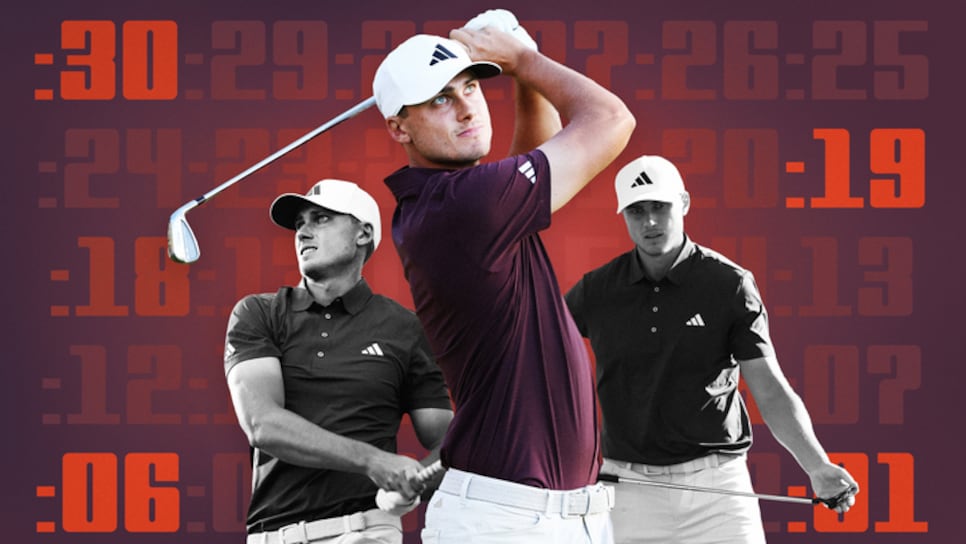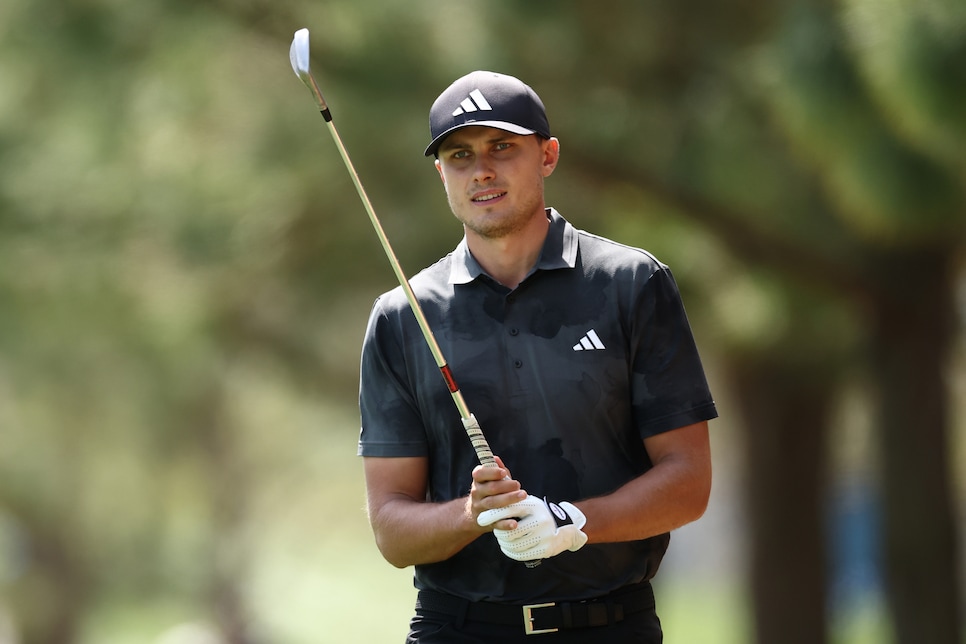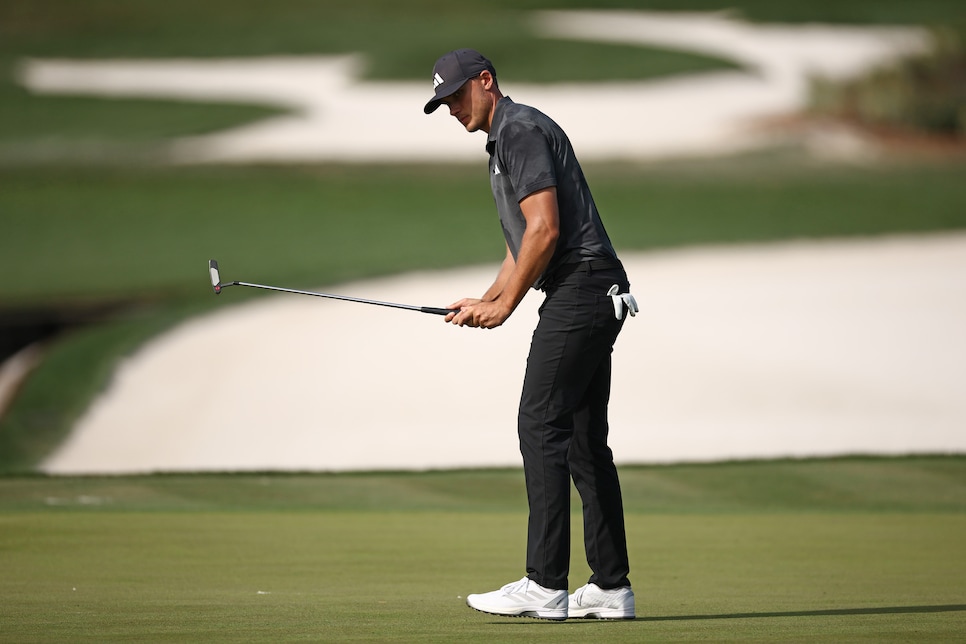speed demon
Players 2025: We timed every shot Ludvig Aberg hit on the front nine. He's even faster than you think

PONTE VEDRA BEACH — While discussing the new pace-of-play initiatives that will be tested on the Korn Ferry Tour next month, PGA Tour commissioner Jay Monahan clarified Tuesday that it's not just being done from a standpoint of negativity. The data the tour is planning to release won't just be focused on the slow-pokes.
"There's also a really positive element to this," he said. "They're celebrating the players that are playing faster and improving, and at the same time there's giving players the information that they need to have to be able to improve in the eyes of not only how they're competing but also in the eyes of our fans."
One man who needs no improvement in this department is Ludvig Aberg, who on Thursday teleported from shot to shot, green to tee box, so quickly that you'd miss it if you were looking down at your phone and mindlessly scrolling social media. Guilty as charged.
On Friday, though, I decided to put my smartphone to much better use. At 1:29 p.m.—the second-round tee time for Justin Thomas, Hideki Matsuyama and Aberg—I pulled up my stop watch app and proceeded to time every single shot Aberg hit on the front nine at TPC Sawgrass. What I came to find out was very similar to what Officer Michaels, the cop played by Seth Rogen in the 2007 comedy "Superbad," found out when he was chasing down Evan, played by Michael Cera, after consuming numerous beers at the bar.
He's a freak, he's the fastest kid alive.
Hole 1
Shot 1: After the first-tee announcer's introduction—"On the tee, Ludvig O-BERG!"—I started the timer. Just a shade under 23 seconds later, the 25-year-old Swede launched a missile down the left side of the first fairway with his driver. And that time included waiting for the smattering of applause to cease.
Shot 2: It looked like Aberg was away, but he pointed to himself to go first instead of Matsuyama. Ready to roll. I hit the timer after that. Twenty-two seconds later, he pulled the trigger, and I may have been a touch late on the stop button (now I understand how NFL scouts can get 40-yard-dash times wrong). A slight pull, but he's dancing.
Shot 3: Aberg is away on the putting surface, 32 feet from the hole. From the time he marks his ball to impact, one minute and 21 seconds elapses. This includes Aberg reading the putt from both sides, as well as finding the mid-point of the putt and taking a practice stroke from there. It also includes caddie Joe Skovron pulling the pin and cleaning his boss-man's golf ball. His birdie effort just misses and he tap-ins in the 12-incher for par.
For comparison's sake, I hit the timer when Matusyama began the process for his 18-footer, which he had the benefit of looking over while Aberg went through his routine. Forty seconds. After he fished his ball out of the cup, I hit the timer for Thomas, who had six feet for birdie. Fifty-eight seconds. Worth it, as Thomas began the day one under.
Hole 2
Shot 1: JT has the honors after the opening bird. Rips a draw around the corner. Timer begins when Aberg's tee goes into the ground and timer stops when the club makes impact with the ball (this was my routine on every tee box). Twenty-six seconds and seven milliseconds. Another gong show, 321 yards around the corner, 11 yards past JT's. And all that was required was one half takeaway back and one look forward.
Shot 2: I hit start the moment after Matsuyama strikes his second. Aberg immediately pulls an iron out of the bag and hits his second 27 seconds later.
Shot 3: Aberg is shortsided, left of a tucked pin. Clock starts when he goes to take a side angle view from the front of the green. He stubs the chip 45 seconds later.
Shot 4: Aberg lets Thomas roll his eagle putt and goes and takes a look from the other side of the hole (his ball is up against the first cut, still not on). Timer starts after Thomas cozies one up and taps in for birdie. Aberg takes a second look from behind the hole and rolls the birdie putt by 37 seconds later. He's still up. Clock restarts. Skovron cleans ball. Three-foot par putt finds hole 21 seconds later.

Jared C. Tilton
Hole 3
Shot 1: Twenty-three seconds. Almost flew it in.
Shot 2: After Matsuyama makes his birdie, clock starts. Aberg begins AimPoint process. In fairness, a crucial five-footer to kick start his round. Took him a minute flat to find the bottom of the cup for a 2.
Hole 4
Shot 1: Aberg waits for Hideki to clear out, removes tee from his mouth (standard habit, apparently) and pegs it. Clock starts. Twenty-six seconds.
Shot 2: Even after stopping for a bathroom break, Aberg gets to his see shot, which found the long bunker down the right side of the short par 4, and he's ready and waiting for both of his playing partners to go first. A 125-yard wedge shot that even other reasonably-fast tour pros might deliberate over for some time. Maybe a toss of the grass to check the wind. A little chit-chat with the caddie. "We like that? ... "Yeah, love it." None of that going on here. Aberg takes 20 seconds to hit. Sails the green. Perhaps he should have taken his time.
Shot 3: Aberg is long and right, facing a devious little flopper out of thick rough to a green sloping away. He takes three practice swings. What the hell is going on? Walks up, takes a quick look, returns. Even when he's "slow," by his standards, everything he's doing is extremely deliberate. You're probably thinking, "wow, this must have been at least over a minute." Thirty-nine seconds.
Shot 4: Long par putt. Thirty-four footer. Thomas' third came to rest directly in his line. Clock started right after Aberg had Thomas move his mark two putter-lengths to the right, which gave him time to take a good look. He nukes it nine feet past 32 seconds later. Hands on hips. Has to mark it. Started clock again from there. He took 46 seconds to stroke a must-have bogey. Misses. Tap-in double. Ouch.
Hole 5
Shot 1: Double-bogey means you're the last guy to hit. After waiting what probably felt like an eternity for him, tee goes in ground and he pulls his driver into the left rough less than 25 seconds later.
Shot 2: An incredibly-difficult second shot awaits. Deep lettuce, side-hill, cut lie. Not putting any spin on this one. Skovron paces off a yardage. Aberg is between clubs. A mini discussion ensues. This is John Catlin-esque (if you know, you know). One minute and 15 seconds. SHAME! SHAME! SHAME!
Shot 3: A nine out of 10 approach that landed short of the green and ran up to 37 feet makes Aberg the first to putt. Clock started when he put his coin down. Took a look behind, another from the middle. Just missed the long birdie try one minute and nine seconds later. Over two minutes to play two shots. Kick him off the tour, Doug.
Hole 6
Shot 1: Players have been befuddled by the new/old tree on the par-4 sixth. Surely, at the snail-like pace Aberg played the hole before, he'd continue to crawl as he decided how to keep it low under the limbs. Nah, 26 seconds flat from tee in ground to impact. Back to business.
Shot 2: Aberg finds a spot of bother, his ball resting underneath a severe lip in the fairway bunker down the left side. All he can do is pitch out. Twenty-six seconds, again.
Shot 3: From 68 yards out, clock started when he and Skovron arrived at the ball. Needs to get up and down for par. Third shot hit 53 seconds later.
Shot 4: Clock begins after Thomas finishes out. Lot of work left for par, nearly 10 feet. He rolls it 46 seconds later and it drops.

Jared C. Tilton
Hole 7
Shot 1: For the first time all day, they catch the group ahead in the fairway. Credit to Maverick McNealy, Tony Finau and—wait for it—Brian Harman (!) for keeping it moving. Thomas goes first, Aberg hits 25 seconds later. Fairway.
Shot 2: JT clips him by five yards. A first on the round. Spoke too soon, as now they are waiting a bit for the group ahead to putt out. Once they leave, Matsuyama goes and clock starts the moment Aberg pulls an iron out of his bag. Twenty-four seconds later, he pulls his 148-yard approach just left of the green. Thomas, from 143 yards, is deciding between clubs. Started clock on him about five seconds after Aberg's shot. He hits 48 seconds later, doubling Aberg's time. No shade. JT was locked in. Wound up making his fourth birdie of the day.
Shot 3: Aberg is waiting on Skovron, already standing at his ball just off the left edge of the putting surface. Skovron is some 120 yards back raking Aberg's divots out of the fairway bunker. What a considerate caddie. Protect the field and all that. Clock starts when Skovron arrives. Aberg chips it to seven feet 25 seconds afterward.
Shot 4: Thomas rolls in birdie and the clock begins. Aberg is much more careful with the mid-range putts than the long-range ones. He's more proficient on those, too, like Kevin Garnett on the Boston Celtics. Drains the par 46 seconds later.
Hole 8
Shot 1: Long par 3. Annually plays as one of the hardest holes on the property (second-hardest this week as of Friday afternoon). Even for the big-hitters like Ludvig, lumber is necessary. Otherwise known as a 24-second process for Aberg.
Shot 2: Another greenside chip. Hideki's away? No, Aberg is. Started the clock a little late, from when Aberg was walking back to his ball after taking a look halfway toward the hole. Chips it to six feet 18 seconds later.
Shot 3: A treacherous left-to-righter for par awaits. He took 46 seconds to bury it and everyone would have understood if he needed 46 more. Thomas, from one foot and four inches closer, took 57 seconds and made it for a 3.
Hole 9
Shot 1: Tee in ground, 24 seconds, impact.
Shot 2: Bit of a wait as the group ahead finishes out. Aberg is ready to go, 3 wood in hand. Clock begins as he puts his glove on. He blasts one just short and right of the green 25 seconds later.
Shot 3: Thomas laid up and nearly holed out for an eagle. Aberg waits for him to walk up and tap in for his fifth birdie on the front. That gave him some time to work through his process. Clock began when JT reached the green. Aberg hits a solid shot to six feet 40 seconds later.
Shot 4: Clock starts when Aberg marks his ball, tosses it to Skovron for a wipe. Clearly, he wanted this one badly, taking over 90 seconds—a half an hour in Ludvig time—to narrowly miss it off the left edge. Par for a one-over 37.
Conclusion
Aberg went on to shoot a sloppy 38 on the back nine for a three-over 75, which, surprisingly, saw him miss the cut by a lot. But he was quick in doing so.
Speaking to PGA Tour official Stephen Cox, I learned the "average shot time" on the PGA Tour normally falls in the 38-second range. When does the clock start? Cox explains.
"There are two ways," Cox says. "A walking scorer hits a console and triggers a stroke hit for the player. Then we have cameras on every tee and green that capture the exact amount of time it takes for those strokes to be hit. For example, Player A hits at 9 a.m. Watches his ball, picks up his tee, clears out. I'm next to play and I hit at 9:01 and five seconds. That's a 65-second delay from me to you.
"But then each group has a referee, and how they calculate is different," he continues. "Once Player A hits and moves, now it's the next players turn. Referee then hits the stop watch. So we have two different versions of a shot clock. One is purely automated based on time stamps, and one is referees with an actual stop watch."
By my personal, stopwatch calculations, Aberg averaged just north of 33 seconds. Five seconds less than the tour average might not sound like much, but it can added up to a lot of saved time over the course of a round and over the course of a season. It's something every player, regardless of status in the game, should aspire to. More importantly, it's something we should celebrate.

